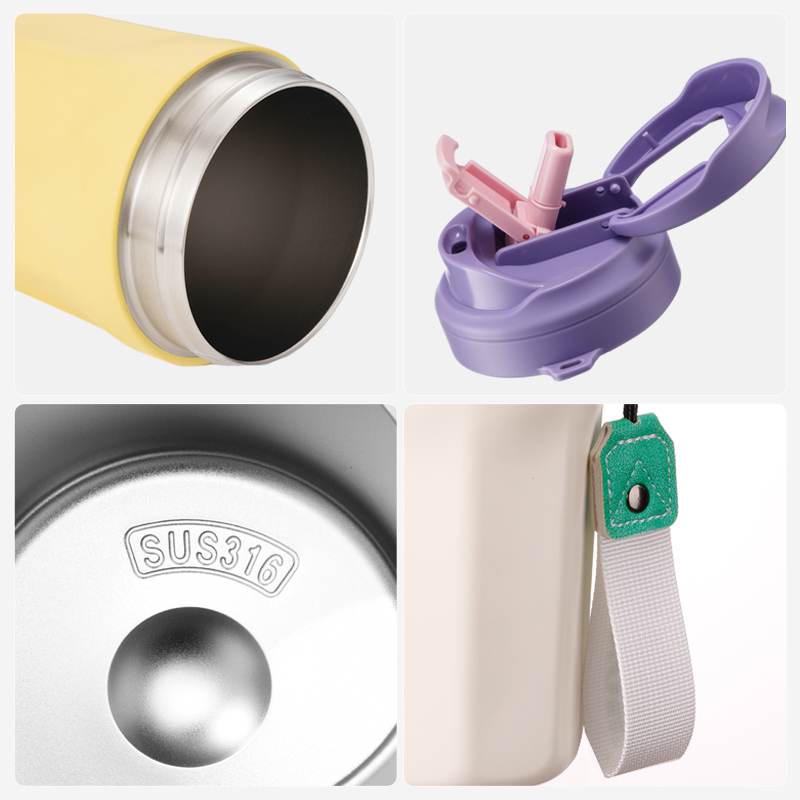The production of thermos cups has changed recently due to the integration of sophisticated automation technologies by a stainless steel-focused vacuum mug factory. At our Stainless Steel Mug Factory, robotic welding, digital printing, and automated inspection systems are being incorporated to improve throughput, consistency, and customization capabilities.
1. Key Automation Technologies in Use
Robotic Welding and Handling
Robots perform precision welding on stainless steel body seams, ensuring airtight vacuum performance.
Automated conveyors move parts between stations, minimizing contamination and handling damage.
Digital Decoration and Custom Labeling
Inkjet and laser engraving systems can produce custom branding, logos, and serial numbers at high speeds.
These digital processes support quick changes in design without downtime, crucial for OEM and ODM orders.
Automated Sealing & Quality Assurance
Torque-controlled lid assembly stations apply consistent pressure and validate sealing strength.
Vision inspection cameras check welds, finishes, and interior cleanliness before packaging.

2. Benefits of Automation for Thermos Production
2.1 Improved Consistency & Reduced Defects
Automated lines deliver consistent weld quality and sealed joints—critical for maintaining insulating vacuum integrity. Defect rates drop sharply compared to manual assembly.
2.2 Increased Throughput & Flexibility
Production speed increases: robots weld and finish far faster than human workers.
Factories can switch between different product types—like wide-mouth stainless steel mugs or narrow vacuum travel cups—without long setup times.
2.3 Enhanced Customization Capacity
With digital printing integrated into production, customers can receive personalized mugs with logos or unique designs—essential for corporate orders or branded drinkware.
3. Industry Case Study: From Manual to Automated Lines
At our facility in Zhejiang, the transformation began in 2022. We developed an automated welding cell for 18/8 stainless steel bodies, followed by digital lid assembly and programmable laser engraving. This enabled:
Scalable OEM production: switching between volumes of 10,000 to 100,000 units per month.
ODM offerings: customers choose from standard vacuum mug models, customizing exterior color or decoration in just hours.
Tighter control over quality: inline inspection reduces the need for post-production checks.
4. Supporting Infrastructure and Talent
Skilled Engineering & Maintenance Team
Robotics and automation require skilled operators and engineers. Our team includes mechanical and electrical engineers responsible for ongoing calibration and efficiency tuning.
In-House Tooling and Mold Development
Because we maintain our own steel mold and plastic mold workshop, changes to part geometry or tooling can be made quickly, enabling new product launches without third-party delays.
Quality Systems & Certifications
All automated stations link into ISO 9001 quality tracking. Additionally, alignment with ISO 14001 (environmental) and ISO 45001 (occupational health) ensures eco-safe and worker‑safe automation implementation.
5. What This Means for Buyers and Partners
Faster delivery times: automation cuts production turnaround, even for customized designs.
Stable unit pricing: process standardization reduces variability in costs.
Higher reliability: repeatable quality means fewer returns and better end-customer satisfaction.
One-stop OEM/ODM service: from tooling to finished product, customers enjoy a streamlined supply chain.
6. Future Developments on the Horizon
Manufacturers are exploring adding AI-driven predictive maintenance to monitor wear on robot welders, predictive analytics to forecast demand trends, and smart systems for real-time packaging optimization. These emerging technologies are likely to become hallmarks of a next-generation vacuum mug factory.
By embracing automation, our vacuum mug factory has shifted from labor‑intensive stainless steel mug production to a high-efficiency, quality‑driven model. This transformation positions us to serve global partners with high volume, customized, and reliable vacuum-insulated drinkware built to last.


 中文简体
中文简体 Español
Español






